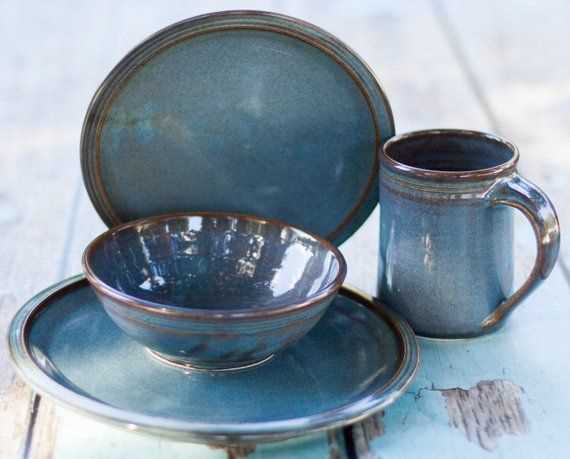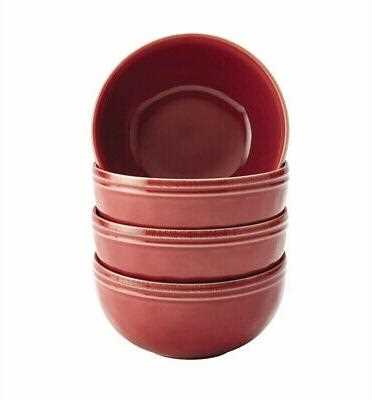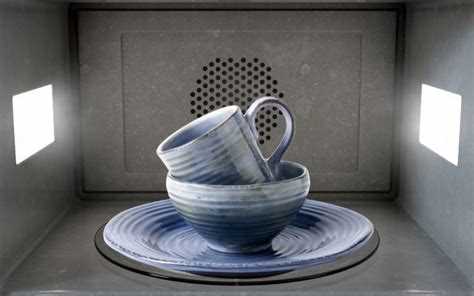If you’re a fan of stoneware, you may be wondering if it’s safe to use in the microwave. Stoneware is a popular choice for kitchenware due to its durability, natural beauty, and ability to retain heat. However, not all stoneware is created equal, and it’s important to know whether your specific piece can handle the heat of the microwave.
Stoneware is made from a type of clay that is fired at a high temperature, making it strong and resistant to chipping and breaking. It is known for its ability to distribute heat evenly, which makes it perfect for baking and roasting in the oven. But when it comes to using stoneware in the microwave, there are a few factors to consider.
Firstly, you need to check whether your stoneware is labeled as microwave-safe. Oftentimes, stoneware will come with a label or stamp indicating whether it is safe to use in the microwave. If it doesn’t have such a label, it’s best to err on the side of caution and avoid using it in the microwave.
If your stoneware is labeled as microwave-safe, it should be able to handle the heat. However, it’s still important to follow some guidelines to ensure safe usage. Avoid sudden temperature changes, such as transferring the stoneware from the fridge directly into the microwave, as it could cause cracking. Always use oven mitts or potholders when handling hot stoneware, as it can retain heat for a long time.
Another consideration is the glaze on the stoneware. Some glazes may contain metallic elements that could cause sparks or create hot spots. If your stoneware has a metallic or shiny glaze, it’s best to avoid using it in the microwave, as it could potentially damage the microwave or even cause a fire.
Ultimately, whether stoneware is microwave-safe depends on the specific piece and its labeling. It’s always a good idea to consult the manufacturer’s instructions or contact the manufacturer directly if you’re unsure. By taking the necessary precautions, you can enjoy the beauty and functionality of stoneware in your microwave, without any safety concerns.
What is Stoneware and How is it Made?
Stoneware is a type of ceramic that is known for its strength, durability, and ability to withstand high temperatures. It is made from a specific type of clay that is fired at a high temperature, resulting in a dense and non-porous material. This firing process gives stoneware its distinctive appearance and properties.
To create stoneware, clay is first harvested and then processed to remove impurities. The clay is then shaped into the desired form, such as plates, bowls, or mugs. This can be done by hand or using molds and pottery wheels. The formed clay is allowed to dry partially to a leathery consistency.
Once partially dried, the clay pieces are fired in a kiln at a high temperature, typically around 1200 to 1300 degrees Celsius. This firing process transforms the clay into stoneware by vitrifying it, which means that the clay particles fuse together and become hard. The high firing temperature also ensures that the stoneware is extremely durable and can withstand the heat from a microwave or oven.
After the initial firing, the stoneware pieces may be left as they are or undergo additional processes. Some pieces may be glazed to give them a smooth and shiny surface, while others may be left unglazed for a more rustic appearance. Glazes can be applied before or after the first firing, depending on the desired effect.
Overall, stoneware is crafted through a careful process that involves shaping the clay, drying it, and firing it at a high temperature. This results in a strong and heat-resistant material that is ideal for use in the kitchen, including in the microwave.
Can Stoneware Be Used in the Microwave Safely?
Stoneware is a popular choice for kitchenware and is commonly used for baking, cooking, and serving dishes. But can stoneware be used safely in the microwave? Let’s find out.
Microwave-Safe Stoneware:
- Not all stoneware is microwave safe.
- Some stoneware may contain metallic elements or glazes that can cause the dish to heat too quickly or unevenly in the microwave.
- Look for stoneware that is specifically labeled as microwave safe. These dishes have been tested and deemed suitable for use in the microwave.
Using Stoneware in the Microwave:
- Before using stoneware in the microwave, carefully read the manufacturer’s instructions and recommendations.
- Make sure the stoneware is clean and free from any food or debris.
- Do not use stoneware dishes with any metallic accents or decorations, as they can cause sparks and damage the microwave.
- Avoid using stoneware that has any cracks, chips, or damage, as it may not be safe for microwave use.
- When heating food in stoneware, use microwave-safe covers or lids to prevent splatters and retain moisture. Leave a small opening for steam to escape.
- Rotate the dish halfway through the cooking time to promote even heating.
Benefits of Using Stoneware in the Microwave:
- Stoneware is known for its excellent heat retention, which means it can help keep your food warm for longer periods.
- Stoneware is also durable and resistant to scratches, stains, and odors.
- It adds a rustic and stylish touch to your table when serving dishes directly from the oven to the table.
However, it’s important to note that stoneware can become very hot when heated in the microwave, so always use oven mitts or pot holders when handling hot stoneware to avoid burns.
Conclusion:
While not all stoneware is microwave safe, there are microwave-safe options available. When using stoneware in the microwave, it’s crucial to follow the manufacturer’s instructions and recommendations to ensure safe and effective use. By taking proper care and precautions, you can enjoy the benefits of using stoneware in your microwave cooking and serving.
Factors to Consider for Microwave Safety
Microwaving food in stoneware dishes is generally safe, but there are a few key factors to consider to ensure microwave safety:
- Material Composition: Stoneware dishes are made from natural clay that is fired at high temperatures, resulting in a durable and heat-resistant material. However, not all stoneware is microwave safe. It is important to check the manufacturer’s instructions or labeling to ensure that the specific stoneware dish is safe for microwave use.
- Metallic Accents: Some stoneware dishes may have metallic accents or decorations, such as gold or silver trim. These metallic elements can cause sparks or arcing in the microwave and should not be used unless specifically labeled as microwave safe.
- Crazing or Cracks: Inspect the stoneware dish for any cracks or crazing (fine lines or cracks on the surface). These imperfections can trap moisture and expand when heated, causing the dish to crack or break in the microwave. It is essential to avoid using damaged stoneware in the microwave.
- Overheating and Uneven Heating: Stoneware dishes are excellent for retaining heat, which can make them susceptible to overheating in the microwave. To prevent overheating, it is recommended to use shorter microwave cooking times and stir or rotate the food during the heating process. This helps to ensure that the heat is distributed evenly and reduces the risk of hot spots.
- Food Safe Glaze: Stoneware dishes are typically glazed to provide a smooth and non-porous surface. This glaze should be food safe and free from lead or other harmful substances. It is crucial to use stoneware dishes that are labeled as food safe and pass relevant safety regulations.
Following these factors will help ensure that your stoneware dishes are microwave safe and can handle the heat without compromising safety or damaging the dish.
Potential Risks of Using Stoneware in the Microwave
While stoneware is generally considered microwave safe, there are still some potential risks associated with using it in the microwave:
- Uneven heating: Stoneware may not heat as evenly as other microwave-safe materials such as glass or ceramic. This can result in hot spots and cold spots in your food, which can lead to uneven cooking or even burning in certain areas.
- Cracking or breaking: Stoneware can be prone to cracking or breaking if it is not properly cared for or if it is exposed to sudden temperature changes. This can happen when transferring stoneware from a hot oven to a cold countertop or when microwaving stoneware that is not microwave safe or appropriate for high-heat cooking.
- Reactivity: Some types of stoneware may react with certain acidic or alkaline foods, causing them to leach harmful chemicals. This can be a concern if you regularly microwave foods that are highly acidic or alkaline, such as citrus fruits or tomato-based sauces.
- Non-microwave-safe glazes: Not all stoneware glazes are microwave safe. Some glazes may contain metallic elements or other components that can cause sparks or other hazards when exposed to the microwave’s heat. It is important to check the manufacturer’s instructions or label to ensure that the stoneware glaze is safe for microwave use.
To minimize these risks, it is important to follow the manufacturer’s instructions for using stoneware in the microwave. Additionally, it is recommended to avoid using stoneware in the microwave for high-heat cooking or for foods that are highly acidic or alkaline. Always inspect your stoneware for any cracks or damage before microwaving, and if in doubt, choose an alternative microwave-safe material for cooking or reheating your food.
Tips for Safely Using Stoneware in the Microwave
If you’re wondering whether stoneware is microwave safe, the answer is generally yes. However, there are some tips you should keep in mind to ensure you can safely use stoneware in the microwave without damaging it or risking any harm:
1. Check for Microwave-Safe Label
Before using stoneware in the microwave, always check whether it has a microwave-safe label or marking. This indicates that the stoneware has been tested and approved for microwave use.
2. Avoid Metallic or Decorative Elements
Avoid using stoneware with metallic or decorative elements like gold leaf or metallic glazes in the microwave. These elements can cause sparks or damage to the microwave.
3. Use Microwavable Stoneware
When purchasing stoneware, look for ones that are specifically labeled as microwave safe. These types of stoneware are designed to withstand the heat of the microwave without cracking or breaking.
4. Avoid Extreme Temperature Changes
Avoid exposing stoneware to extreme temperature changes. For example, do not transfer stoneware from the freezer directly to the microwave, as the sudden change in temperature can cause it to crack.
5. Preheat the Stoneware
If you need to heat stoneware in the microwave, it’s a good idea to preheat it before placing hot food on it. This can help prevent thermal shock and reduce the risk of cracking.
6. Microwave in Short Intervals
When heating or cooking food in stoneware, it’s best to microwave in short intervals and stir or rotate the food regularly. This helps to distribute the heat evenly and prevent hot spots that can cause the stoneware to crack.
7. Use Oven Mitts or Pot Holders
Remember that stoneware can become hot in the microwave. Always use oven mitts or pot holders to handle hot stoneware to avoid burns.
8. Avoid Rapid Boiling
Do not use stoneware in the microwave for boiling liquids, such as water for tea or soup. The stoneware can become extremely hot and may cause the liquid to boil rapidly, creating a potential hazard.
9. Allow for Cooling Time
After heating or cooking in the microwave, allow the stoneware to cool before handling it. This helps prevent burns and allows the stoneware to stabilize at room temperature.
10. Inspect for Damage
Regularly inspect your stoneware for any signs of damage, such as cracks or chips. If you notice any damage, discontinue using the stoneware in the microwave as it may pose a safety risk.
By following these tips, you can safely use stoneware in the microwave and enjoy the convenience of heating and cooking your favorite foods without worrying about damaging your stoneware or the microwave itself.
Alternatives to Using Stoneware in the Microwave
While stoneware is a popular and versatile material for kitchenware, it may not always be the best choice for use in the microwave. Fortunately, there are several alternative materials that are microwave-safe and can handle the heat. Here are some alternatives to consider:
Glass
Glassware, such as Pyrex or tempered glass, is a great option for microwave use. It is resistant to high temperatures and can handle the heat without cracking or breaking. Glass is also transparent, allowing you to easily monitor the cooking process.
Ceramic
Ceramic cookware, specifically those labeled as microwave-safe, can be a suitable alternative to stoneware. These pieces are designed to withstand the heat of the microwave and will not release any harmful chemicals. However, it’s important to check the manufacturer’s guidelines to ensure the specific ceramic piece is safe for microwave use.
Silicone
Silicone microwave-safe containers have become popular due to their flexibility, durability, and heat resistance. They can go from freezer to microwave without any issues and are easy to clean. Just make sure to choose containers that are explicitly labeled as microwave-safe.
Plastic
Plastic containers can be used in the microwave, but it’s essential to choose microwave-safe plastic. Look for containers that are labeled as BPA-free and specifically designed for microwave use. It’s also recommended to use plastic containers with vented lids to allow steam to escape during cooking.
Paper
Paper towels, wax paper, and parchment paper can be used to cover food in the microwave, helping to reduce mess and splatters. However, it’s important to note that not all types of paper are microwave-safe. Make sure to check the packaging or use microwave-safe papers to prevent any potential fire hazards.
When choosing an alternative to stoneware, always check the manufacturer’s guidelines to ensure the product is safe for microwave use. Follow the recommended usage instructions for the best results.
FAQ:
Can I put stoneware in the microwave?
Yes, you can put stoneware in the microwave. Stoneware is microwave safe and can handle the heat.
Is it safe to microwave stoneware dishes that have metallic accents or decorations?
No, it is not safe to microwave stoneware dishes with metallic accents or decorations. The metal can cause the dish to heat unevenly and potentially damage your microwave.
What is the maximum temperature that stoneware can withstand in the microwave?
Stoneware can generally withstand high temperatures in the microwave, with some brands claiming they can handle temperatures up to 500°F or more. However, it is always best to refer to the manufacturer’s instructions for specific temperature guidelines.
Can I use stoneware in a convection microwave oven?
Yes, you can use stoneware in a convection microwave oven. Stoneware is designed to handle high temperatures and can be used safely in both conventional and convection microwave ovens.
Can stoneware crack or explode in the microwave?
While it is rare, stoneware can crack or explode in the microwave under certain conditions. Rapid temperature changes, such as placing a cold stoneware dish in a hot microwave or heating a dish with uneven thickness, can cause it to crack or break. It is important to follow the manufacturer’s guidelines and avoid sudden temperature changes to prevent accidents.


